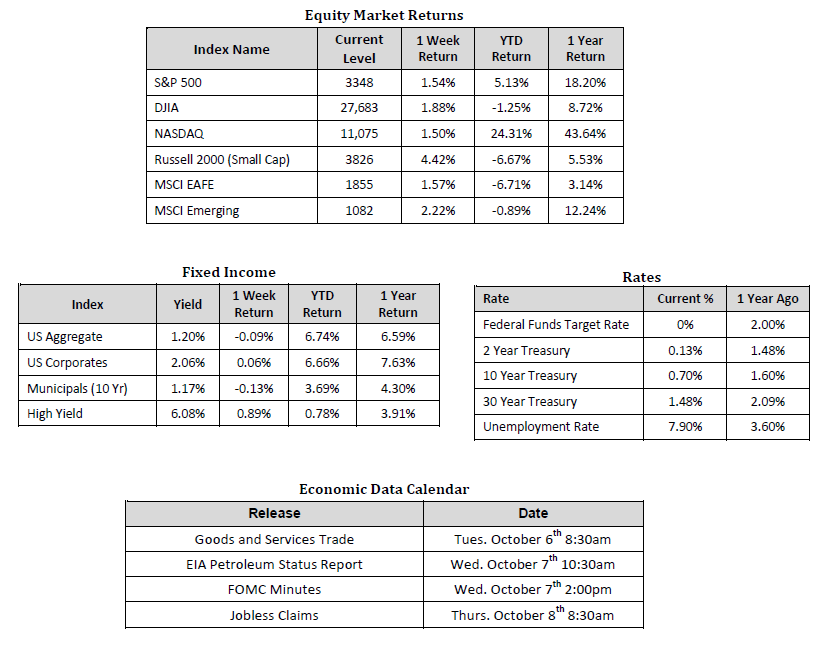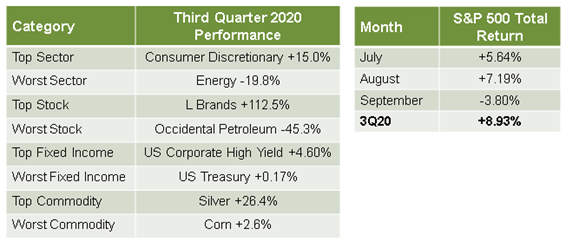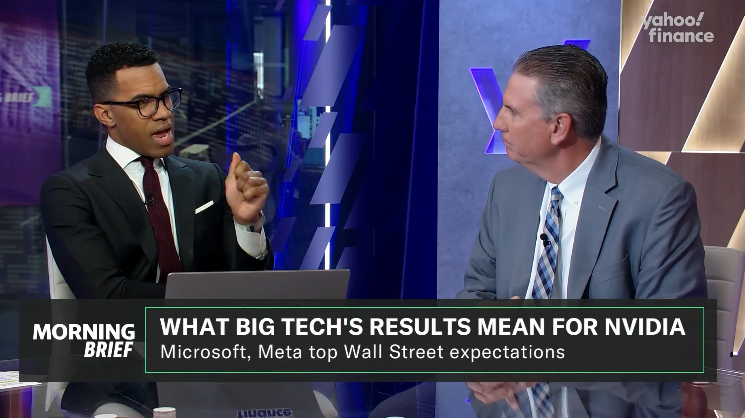
Last Week’s Markets in Review: Third Quarter Scorecard

Equity markets finished the week in positive territory as investors had plenty of information to evaluate regarding politics, the economy, and COVID-19. In the U.S., the S&P 500 Index rose to a level of 3,348, representing a gain of 1.54%, while the Russell Midcap Index moved 3.18% higher last week. Meanwhile, the Russell 2000 Index, a measure of the Nation’s smallest publicly traded firms, led the pack rising 4.42% over the week. International equities also experienced gains across geographies as developed and emerging markets returned 1.57% and 2.22%, respectively. Finally, the yield on the 10-year U.S. Treasury crept up slightly, finishing the week at 0.70%, up four basis points from the week prior.
Stocks snapped a five month winning streak to close out the month of September. The market reached all-time highs in August and the heightened valuations, combined with an increased mindfulness of uncertainties and headwind risks kept markets from moving higher. The S&P 500 Index gained 8.93% for the quarter while the Dow and NASDAQ returned 8.22% and 11.23% respectively. Below is a brief scorecard of what worked, and what didn’t, in Q3 2020.

Source: Bloomberg. Top stocks and sectors of the S&P 500 Index.
Although September was a disappointing month, the quarter as a whole was strong. The S&P 500 Index built on an even bigger gain during the 2nd quarter, resulting in the best two-quarter performance stretch for the S&P 500 since 2009.
Looking ahead, we expect the broad markets overall to likely remain rangebound for the remainder of the year. Instead of headwinds and tailwinds, we will potentially have…no winds. Many factors could tip the scales one way or the other including potential additional fiscal stimulus, vaccine trial news, and reopening updates to name a few. Markets will continue to trade on related news one way or the other, but we believe at this time that progress on many of these fronts thus far should provide a support level for stocks. Regardless, investors will need to be even more selective when identifying growth and income opportunities that are available in the fourth quarter and should expect more days of heightened volatility through the end of the year.
We continue to encourage investors to stay disciplined and work with experienced financial professionals to help manage their portfolios through various market cycles within an appropriately diversified framework that is consistent with their objectives, time-frame, and tolerance for risk.
We recognize that these are very troubling and uncertain times and we want you to know that we are always here for you to help in any way that we can. Please stay safe and stay well.
Sources for data in tables: Equity Market and Fixed Income returns are from JP Morgan as of 10/2/20. Rates and Economic Calendar Data from Bloomberg as of 10/2/20. International developed markets measured by the MSCI EAFE Index, emerging markets measured by the MSCI EM Index, U.S. Large Cap defined by the S&P 500. Sector performance is measured using GICS methodology.
Disclosures: Past performance does not guarantee future results. We have taken this information from sources that we believe to be reliable and accurate. Hennion and Walsh cannot guarantee the accuracy of said information and cannot be held liable. You cannot invest directly in an index.
Diversification can help mitigate the risk and volatility in your portfolio but does not ensure a profit or guarantee against loss.
Investing in commodities is not suitable for all investors. Exposure to the commodities markets may subject an investment to greater share price volatility than an investment in traditional equity or debt securities. Investments in commodities may be affected by changes in overall market movements, commodity index volatility, changes in interest rates or factors affecting a particular industry or commodity.
Products that invest in commodities may employ more complex strategies which may expose investors to additional risks.
Investing in fixed income securities involves certain risks such as market risk if sold prior to maturity and credit risk especially if investing in high yield bonds, which have lower ratings and are subject to greater volatility. All fixed income investments may be worth less than the original cost upon redemption or maturity. Bond Prices fluctuate inversely to changes in interest rates. Therefore, a general rise in interest rates can result in the decline of the value of your investment.
Definitions
MSCI- EAFE: The Morgan Stanley Capital International Europe, Australasia and Far East Index, a free float-adjusted market capitalization index that is designed to measure developed-market equity performance, excluding the United States and Canada.
MSCI-Emerging Markets: The Morgan Stanley Capital International Emerging Market Index, is a free float-adjusted market capitalization index that is designed to measure the performance of global emerging markets of about 25 emerging economies.
Russell 3000: The Russell 3000 measures the performance of the 3000 largest US companies based on total market capitalization and represents about 98% of the investible US Equity market.
ML BOFA US Corp Mstr [Merill Lynch US Corporate Master]: The Merrill Lynch Corporate Master Market Index is a statistical composite tracking the performance of the entire US corporate bond market over time.
ML Muni Master [Merill Lynch US Corporate Master]: The Merrill Lynch Municipal Bond Master Index is a broad measure of the municipal fixed income market.
Investors cannot directly purchase any index.
LIBOR, London Interbank Offered Rate, is the rate of interest at which banks offer to lend money to one another in the wholesale money markets in London.
The Dow Jones Industrial Average is an unweighted index of 30 “blue-chip” industrial U.S. stocks.
The S&P Midcap 400 Index is a capitalization-weighted index measuring the performance of the mid-range sector of the U.S. stock market and represents approximately 7% of the total market value of U.S. equities. Companies in the Index fall between S&P 500 Index and the S&P SmallCap 600 Index in size: between $1-4 billion.
DJ Equity REIT Index represents all publicly traded real estate investment trusts in the Dow Jones U.S. stock universe classified as Equity REITs according to the S&P Dow Jones Indices REIT Industry Classification Hierarchy. These companies are REITs that primarily own and operate income-producing real estate.



